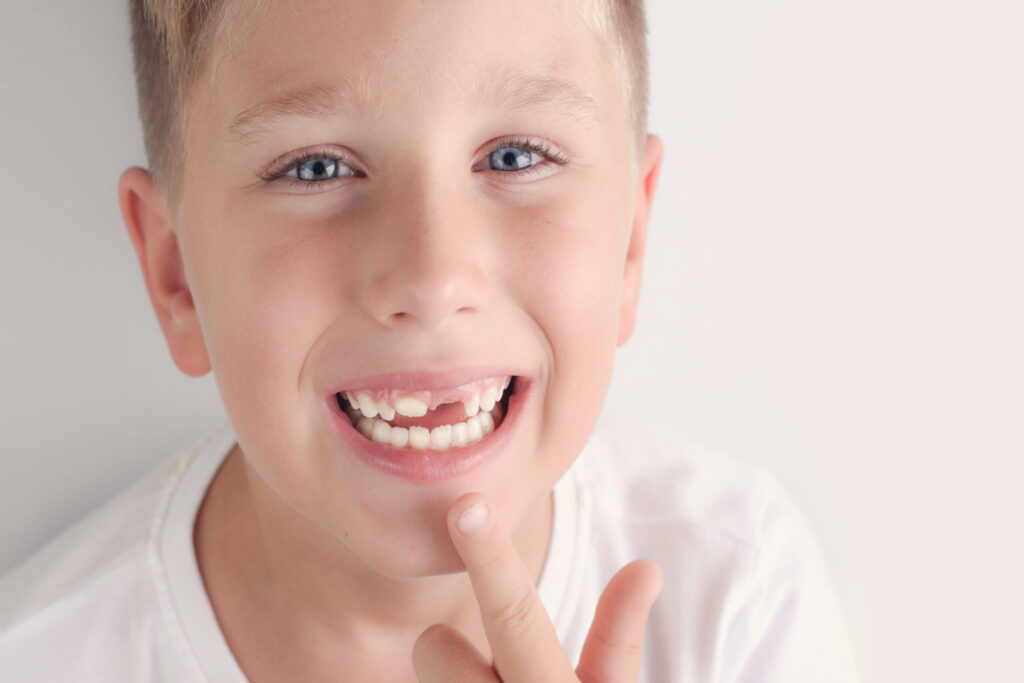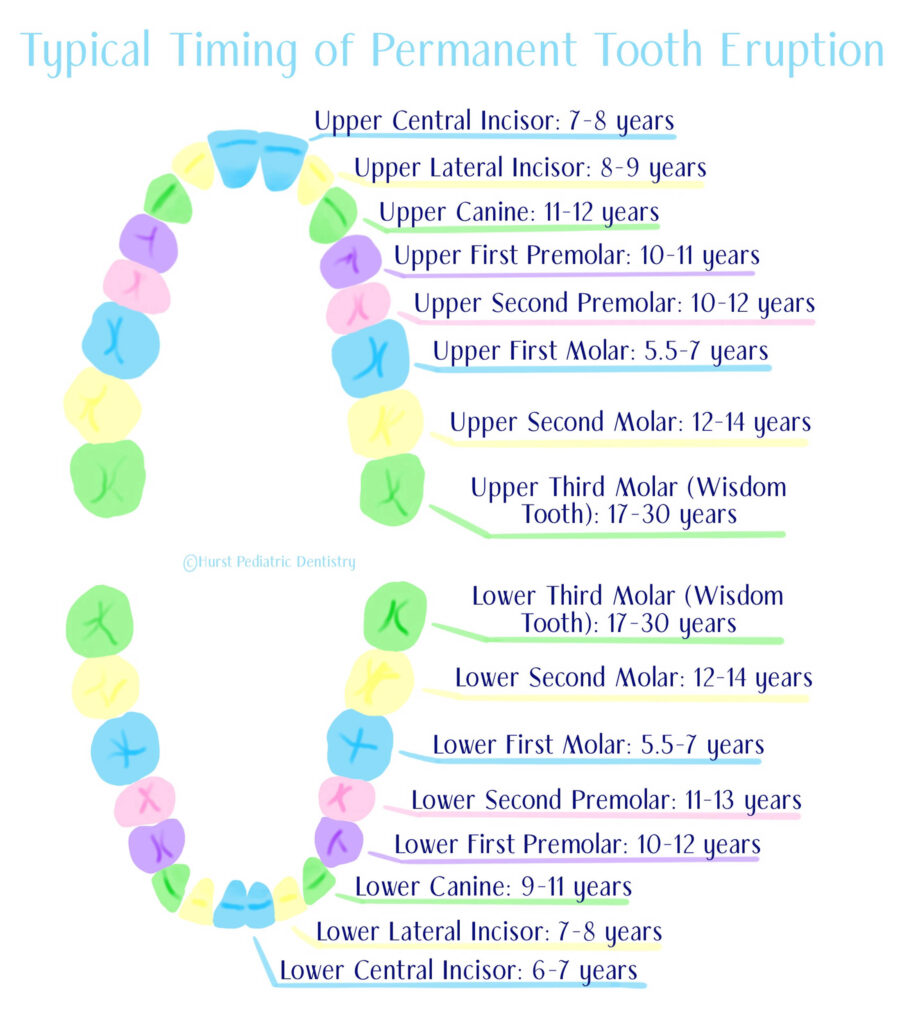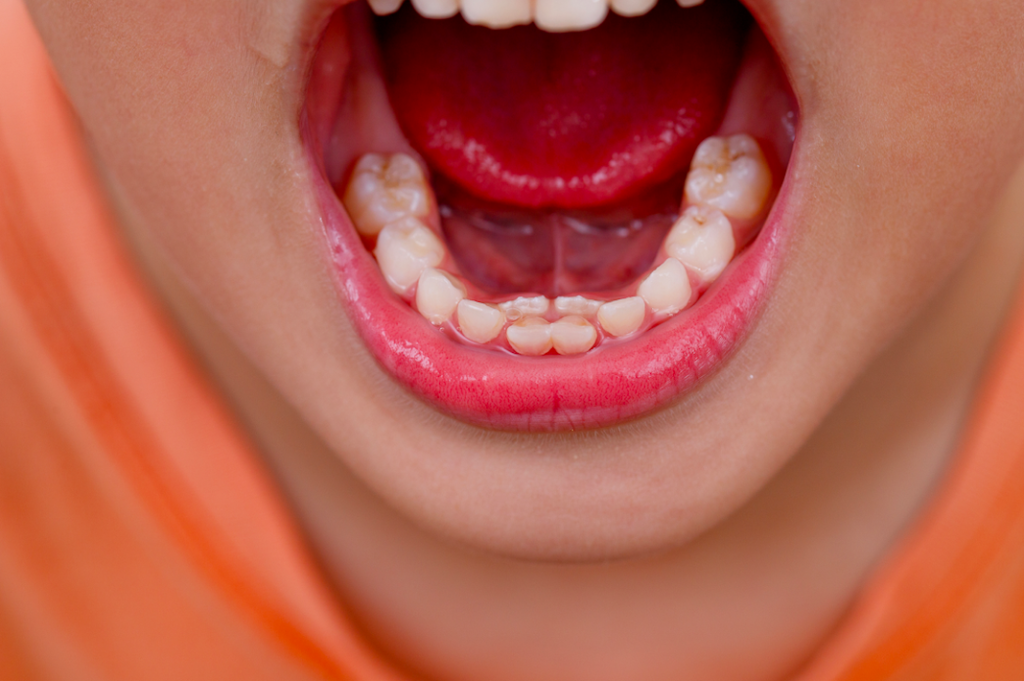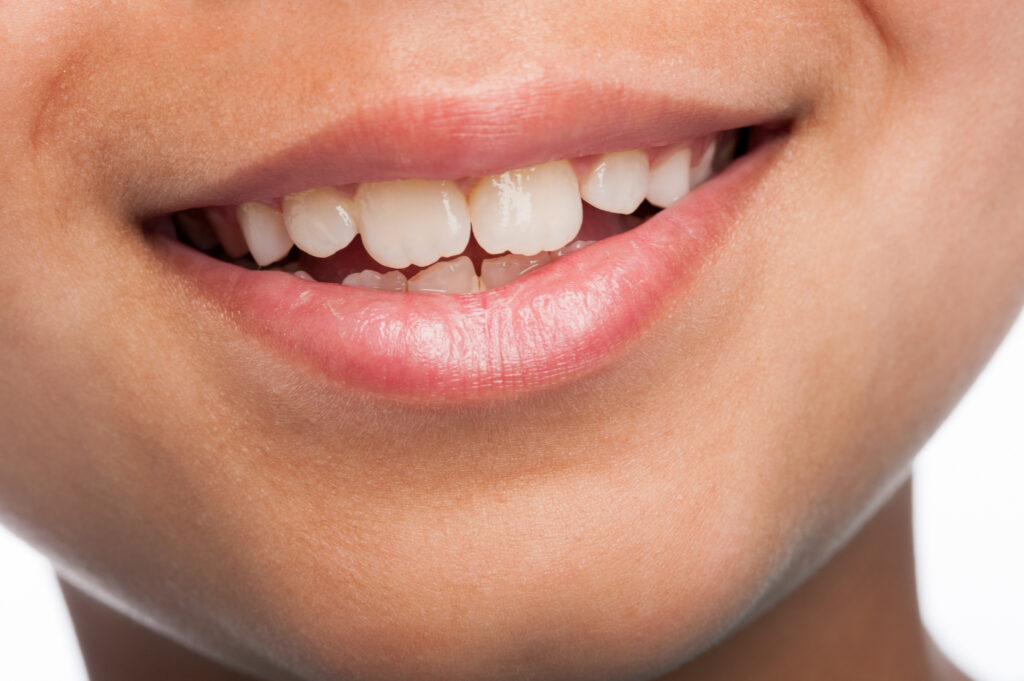When Do Kids Get Their Permanent Teeth?

Is your child approaching the age where you’re starting to wonder when those first permanent teeth will show up? Or has your child already started getting permanent teeth, but the process isn’t going quite as you had expected? If you find yourself filled with questions about your child’s new permanent teeth, you are not alone. In fact, many of the questions we receive most frequently at our practice relate to the emergence of children’s permanent teeth.
In this article, we will cover the following frequently-asked-about topics:
- When Do Children’s Permanent Teeth Come In?
- Is My Child Losing Baby Teeth Too Early?
- Why Aren’t My Child’s Permanent Teeth Coming In?
- Do Permanent Teeth Ever Grow In Before Baby Teeth Fall Out?
- What Are the Bumpy Ridges Along the Edges of My Child’s Teeth?
- Why Do My Child’s New Permanent Teeth Look Yellow?
When Do Children’s Permanent Teeth Come In?
If the thought of your child getting that first permanent tooth brings to mind visions of the tooth fairy, you may be surprised to learn that a child’s first permanent tooth usually is not one that replaces a lost baby tooth. Instead, the first permanent teeth to come in are generally a child’s “first molars,” which erupt in the empty space in the back of the gums when the child is somewhere between the ages of 5 and 7. These so-called “first molars” are not actually the first molars your child will have – a child’s set of primary (“baby”) teeth includes eight molars – but they are the first permanent molars your child will get. Rather than replacing primary teeth, your child’s “first molars” will increase your child’s total number of teeth from 20 to 24.
Once the first molars have erupted, children start losing their baby teeth and growing replacement permanent teeth. The mandibular central incisors (the bottom front teeth) are typically the first to fall out and are generally replaced with permanent teeth when a child is between 6 and 7 years old. Baby teeth continue to fall out, and permanent teeth continue to replace them, until a child is around 11 to 13 years old.
Once all of a child’s primary teeth have been replaced, the child will usually grow an additional four permanent molars between ages 12 and 14 and, possibly, four wisdom teeth between ages 17 and 30, increasing your child’s total number of teeth to 32.
The chart below shows the typical timing for the eruption of each permanent tooth. Keep in mind that deviations from these numbers do not necessarily indicate a problem. Many children lose baby teeth and grow permanent teeth outside of the typical order and/or age ranges. If you are concerned that your child is losing baby teeth too soon or that your child’s permanent teeth aren’t coming in on time, keep reading for more information.

Is My Child Losing Baby Teeth Too Early?
If your child is losing primary teeth at an age significantly younger than the typical ages listed above, it’s a good idea to consult your child’s pediatric dentist to ensure there are no underlying problems. This is especially true if no permanent teeth are growing in to fill the empty spaces. For more information about why some children lose teeth too early, check out our article on premature primary tooth loss.
Why Aren’t My Child’s Permanent Teeth Coming In?
What if all of your child’s classmates seem to be getting regular visits from the tooth fairy, but your child still hasn’t lost a single baby tooth? What if your child lost a baby tooth months ago, but there’s still no sign of the permanent replacement tooth? Should you be worried? Not necessarily.
Children lose their baby teeth and grow in permanent teeth at their own pace, and it can be completely normal for a child’s permanent tooth to emerge later than you might expect.
That said, if the timing of your child’s permanent tooth eruption seems significantly outside of the average ranges listed above, it is a good idea to check in with your child’s pediatric dentist. In some cases, the failure of a permanent tooth to erupt can signal a problem. To provide a few examples:
- Sometimes permanent teeth are unable to erupt because there simply is not a wide enough gap for them. In such cases, your child’s dentist may recommend extracting the primary tooth that is blocking the permanent tooth’s emergence.
- An impacted tooth – i.e., one whose tooth bud is positioned incorrectly – may be blocked from erupting through the gums. The appropriate treatment for an impacted permanent tooth depends on a number of factors, including the cause of the impaction. For instance, if the impaction is caused by an odontoma (a tumor in the jaw), the odontoma may need to be surgically removed. As another example, if the impaction is the result of dental trauma, tooth extraction or interceptive orthodontic treatments may be necessary.
- Sometimes permanent teeth don’t emerge because the teeth never developed. This condition, called hypodontia, may or may not require treatment, depending on the number and location of missing permanent teeth. Possible treatment options that may be recommended for hypodontia include orthodontic treatment, dental bridges or dental implants.
- In rare cases, a child may have a permanent tooth that fails to emerge even though the tooth bud has developed and has a clear pathway for eruption. This condition is known as primary failure of eruption, and its causes are not well understood. In some cases, a pediatric dentist might refer a child with primary failure of eruption to an orthodontist for treatment.
If the eruption of your child’s permanent teeth appears to be delayed, a pediatric dentist can use dental x-rays to see what is happening underneath your child’s gums and help determine whether your child has crowding problems, impacted teeth, hypodontia, primary failure of eruption, or any other issues that are preventing proper eruption.
Do Permanent Teeth Ever Grow In Before Baby Teeth Fall Out?
In short, yes, and it happens more commonly than you might think.
Typically, when a permanent tooth begins erupting, it pushes against the roots of the primary tooth it is going to replace. This causes the roots of the primary tooth to dissolve, resulting in a baby tooth that becomes loose and eventually falls out.
However, this process does not always work correctly. When an erupting permanent tooth does not properly push against the roots of the corresponding primary tooth, the permanent tooth can grow in without the primary tooth becoming loose. The result is a double row of teeth, sometimes referred to as “shark teeth.”
Parents often wonder whether children with shark teeth require any form of treatment. The answer depends on a wide variety of factors. For example, is the over-retained primary tooth impeding proper brushing? Is it causing pain or discomfort? Is it forcing the child’s permanent teeth to erupt improperly, potentially leading to future orthodontic problems?
In many cases, no treatment is necessary and the baby tooth will eventually fall out on its own. In other cases, a pediatric dentist may recommend extracting the offending baby tooth.

What Are the Bumpy Ridges Along the Edges of My Child’s Teeth?
One of the most common questions we get when a child’s permanent teeth start coming in is why the teeth have ridges along the edges. These bumpy ridges are called mamelons, and they are completely normal.
Mamelons appear on newly erupted incisors (the four front teeth on the top and the four front teeth on the bottom). They are not harmful and do not require treatment. In fact, they often smooth out naturally over time as a result of normal chewing. However, if the ridges are causing aesthetic concerns for your child, a pediatric dentist can easily smooth them out.

Why Do My Child’s New Permanent Teeth Look Yellow?
Parents are often concerned when they notice that their children’s new permanent teeth appear yellow in comparison to their baby teeth, but this color difference usually is not cause for concern.
Teeth are composed of layers. The outermost layer of the visible portion of a tooth is made up of an extremely hard, translucent material called dental enamel. Beneath the enamel lies dentin, which is typically a yellowish color. Because permanent teeth contain a thicker layer of dentin than primary teeth do, permanent teeth naturally appear slightly more yellow.
If you notice that your child’s new permanent teeth are a drastically different color than his or her other teeth, it is probably worth checking with your child’s dentist since, in some cases, color abnormalities can signal dental enamel defects. But a minor color difference between permanent teeth and baby teeth is completely normal.
Board-Certified Pediatric Dentist in Hurst, TX
Still have questions? Give us a call at (817) 510-6400! We love it when our patients’ parents take an active interest in their children’s oral health, and we are happy to answer their questions and schedule an appointment if needed.
Hurst Pediatric Dentistry is located in Hurst, Texas, and provides dental care to children from Hurst, Euless, Bedford, Colleyville, North Richland Hills, Watauga, Fort Worth and the surrounding area.
This article is intended to provide general information about oral health topics. It should not be used to diagnose or treat any disease or as a substitute for the advice of a healthcare professional who is fully aware of and familiar with the specifics of your case. Always seek the advice of your dentist or other qualified healthcare provider with any questions you may have regarding a medical condition or treatment.
MEDICALLY REVIEWED BY:
Dr. Jin Lin

Dr. Jin Lin is a board-certified pediatric dentist with a passion for helping children achieve healthier, more beautiful smiles. He earned his Bachelor of Science degree from Cornell University and his Doctor of Dental Medicine (D.M.D.) degree from the Harvard School of Dental Medicine. After graduating cum laude from dental school, he completed his post-doctoral pediatric dentistry training at Boston Children’s Hospital and the Harvard School of Dental Medicine, where he served as chief resident and worked with children with a wide variety of special medical and dental needs, including children with rare syndromes.

